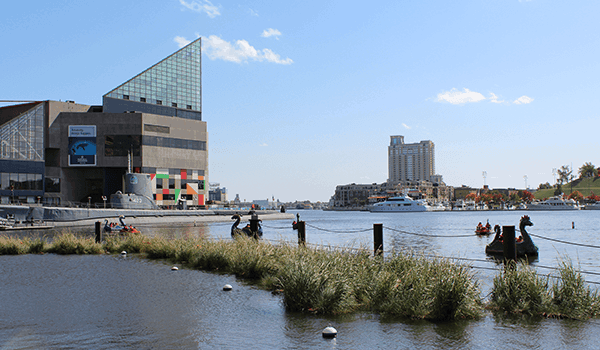
What’s your role in the organization? I am the Director of Advocacy and the Baltimore Harbor Waterkeeper, so I run our waterkeeper program. I started full-time in January.
What’s a waterkeeper? Overall, a waterkeeper is an advocate for clean water, someone who really is a watchdog for our watershed. I honestly don’t think there is one cookie-cutter model for how to be a waterkeeper. I happen to be an attorney. You don’t have to be an attorney. We see people who have more of a background in science. But the person who holds the title waterkeeper really is the spokesperson for those waterways. We are part of an international organization, the Waterkeeper Alliance. There are over 300 waterkeeper organizations in 35 different countries.
So what does Blue Water Baltimore’s waterkeeper program do? We have a couple of scientists on staff and we go out [into streams and the harbor] to do water quality sampling. We post all of the data that we get on a website called Harbor Alert. The general public can go online and learn about the water quality. Then we also have an advocacy program, where we work directly with government agencies. We work in Annapolis on legislative initiatives and then, in some cases, we bring lawsuits that hold polluters accountable when they’ve broken the law.
The waterkeeper program is just one of many programs Blue Water Baltimore runs. What are some of the other initiatives? We also have an urban forestry program where we go out and plant trees. We run the Herring Run Nursery that sells native plants. Stormwater—or rainwater that comes down over hard surfaces and washes chemicals and trash directly into the harbor—is a big problem. So we often work with faith-based organizations, places of worship, churches, schools, to help them design rain gardens and install less asphalt, things like that. All of our volunteer and education outreach programs are free. We have a calendar of different volunteer events.
You mentioned working in Annapolis. The state legislature is in session right now. What are Blue Water Baltimore’s legislative priorities for this session? We really focus on the main threats to the greater Baltimore area: stormwater runoff, sewage spills, and trash. Trash is a huge source of pollution in Baltimore, and there are steps that we can take to reduce that trash. One is the bill that’s in front of the legislature right now to phase out what’s called expanded polystyrene [aka Styrofoam food packaging]. It’s the second-most collected form of trash that we see in Mr. Trash Wheel and Professor Trash Wheel. The first is cigarette butts.
Why polystyrene? What’s so bad about it, aside from its abundance? Not all trash is created equal. [Polystyrene] is almost impossible to clean up because when it gets wet it breaks down into smaller and smaller pieces. Those tiny pieces have chemicals in them and they absorb 10 times more chemicals than other forms of plastic. So what you end up with are tiny little toxic balls of polystyrene that really never leave the environment. The marine animals do eat them and then absorb the toxins and then if we fish and we eat them it can come back to us. There’s a lot of interest in this, the idea of the traceability: Do the chemicals bio-accumulate and then get passed to humans? Frankly, as a mother, I would just follow the precautionary principle. If I had the option to feed my child a fish that ate plastic and one that didn’t, I would choose the one that didn’t. I don’t have to wait for a study to tell me.
What’s the chance of the bill passing? It’s hard to speculate. We have a lot of great bipartisan support. It’s been heard in two committees, so we’re expecting a vote. It is important to note that [polystyrene] laws are in place in Price George’s County and Montgomery County, so Baltimore is really the remaining large populated area in Maryland that doesn’t have this. The bill that would really just level the playing field across the state.
In some ways, it’s curious that we have the trash problem that we do. The vast majority of Baltimoreans probably would say they love the harbor and the bay, but that doesn’t necessarily translate into action and behavior. What’s the disconnect? Yeah, I think a lot of people don’t necessarily understand the way our storm drain system works. We’ll see some folks who are trying to be helpful sweep trash down into the storm drain and assume that the storm drains go to a collection system, but that’s not true. We have a three pipe system underground in Baltimore. We have a drinking water pipe. We have our sewage pipe, and then we have our storm drains and storm water collection pipe. And our storm water collection system literally goes, untreated, directly into the harbor. So it takes all of the trash, all of the chemicals that get washed down from cars on the road. So a lot of it, I think, is an education campaign to try to get people to understand how the system works.
How do you reach people who think that this is boring, do-gooder stuff? It’s a multi-pronged approach and we try to meet people where they are. We try to get them to understand that it does affect us all. So some people might not be concerned that the trash is getting into the harbor, but if they learn that their children in school are being served hot lunches on these expanded polystyrene trays and the EPA has found that [those trays] leach styrene, which is a suspected carcinogen, into the food, then they might care very much because they care about the health and safety of their children. I think it’s trying to identify what issues are important to people and helping them to understand that the work that we do really does touch every aspect of your life, even if you don’t necessarily go out and fish and swim.
How much of a problem are sewage leaks in Baltimore City? We hear about them all the time. It is a huge problem. As I mentioned, Baltimore does have a three pipe system, so there is a separate pipe for sewage, but it is extremely old and the pipes do burst a lot. In 2016 there were 484 reports of sewage overflows in Baltimore City, so that’s more than one a day. It was something like 11 million gallons of raw sewage. We also have many instances of raw sewage backing up into people’s basements. The city is currently working on upgrading its sewage system.
Right. The city was supposed to have it done by 2016. The city entered into a public consent decree agreement with the EPA and Maryland Department of the Environment [MDE] in 2002. They were supposed to have completed the work by 2016, but they failed to meet that deadline and they’ve asked for an extension. Blue Water Baltimore, along with some partners, submitted very robust comments regarding that consent decree in 2016, and we actually filed a motion in court to formally intervene. That motion was approved, so we are now considered a third-party intervener to that case. We are currently in confidential settlement negotiations to work that out.
Negotiations for what, exactly? The negotiations are for a new set of plans, which include not just deadlines but interim deadlines, water quality monitoring, there are a lot of specifics. So that’s currently being worked out and we’re happy to have a seat at the table. Ultimately, all parties share the same goal, which is to clean up the sewage as soon as possible.
What has been the hold up on the city’s part? Is it mismanagement? Is it a lack of funding? Because it’s before my time I wouldn’t want to speculate. It’s certainly a sensitive topic.
Turning to national news, the Trump administration’s proposed 2018 federal budget would eliminate funding to the Chesapeake Bay cleanup program, which doles out grants and coordinates cleanup efforts among the six states and District of Columbia whose waterways feed the bay. What effect would this move have on the bay, which is finally showing signs of improvement? Obviously, that’s a serious concern. I think it’s important to note—not that I’m not alarmed by it, because I am—but that budget is largely symbolic and expresses the direction and priorities of the new administration. That in and of itself is very concerning. That said, it really is Congress that sets the budget, so all hope is not lost yet. But without having strong federal leadership to get all of the different states to enforce and comply and meet the benchmarks that they need, reaching our goal will be much more difficult.
It’s not just the Chesapeake Bay Program that would be cut. The EPA itself would sustain deep cuts. Furthermore, Scott Pruitt, the EPA’s new administrator, doesn’t believe the EPA as we know it should even exist. In general, how bad a time is it to be a clean water advocate? The news coming out of Washington every day is certainly bleak. And yes, it can be very overwhelming at times—just the number of threats that we have to clean water. It’s a unique situation. But again, I think it just underscores how much more important it is to focus on the local level and the changes we can make here—and there’s a lot we can do.
